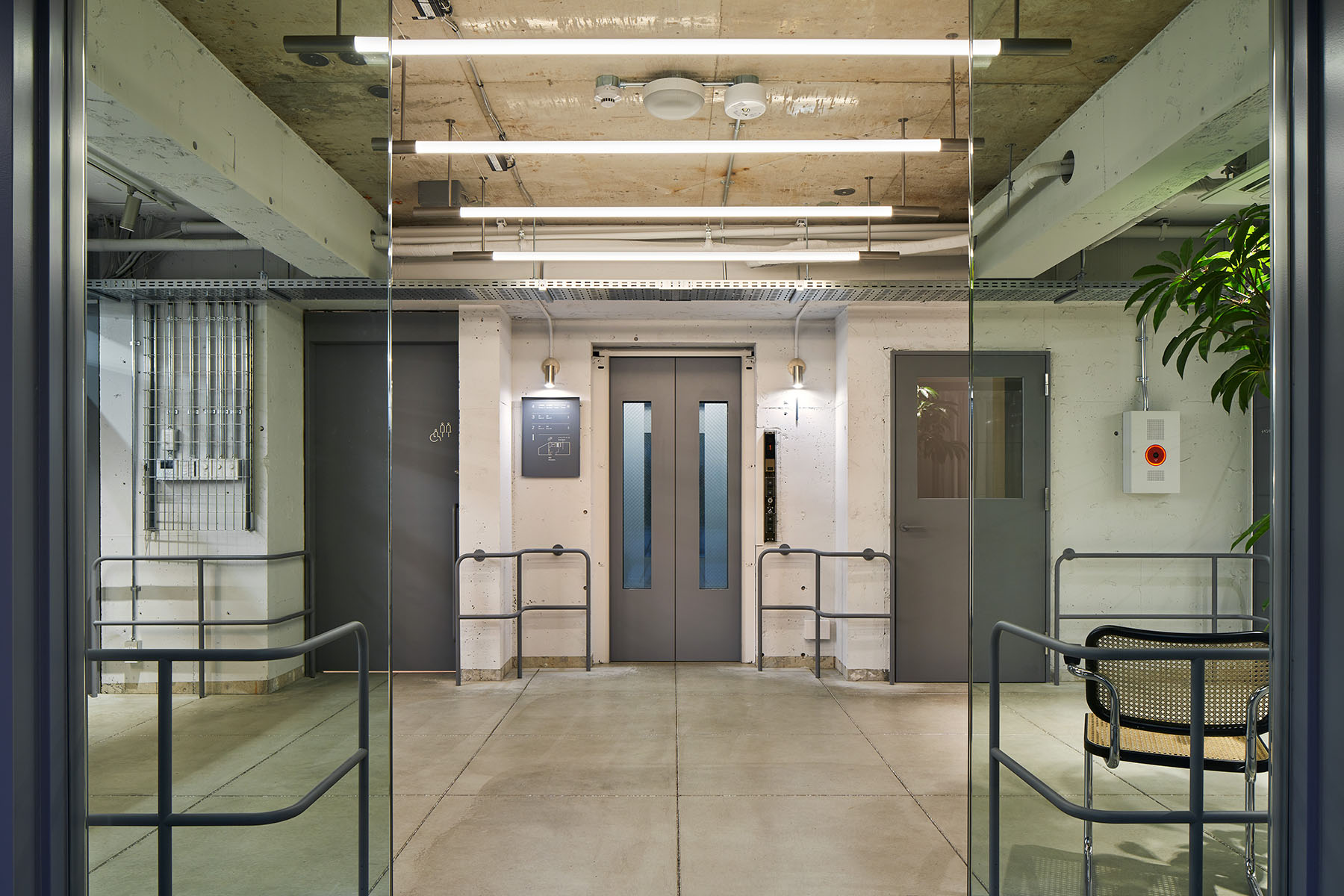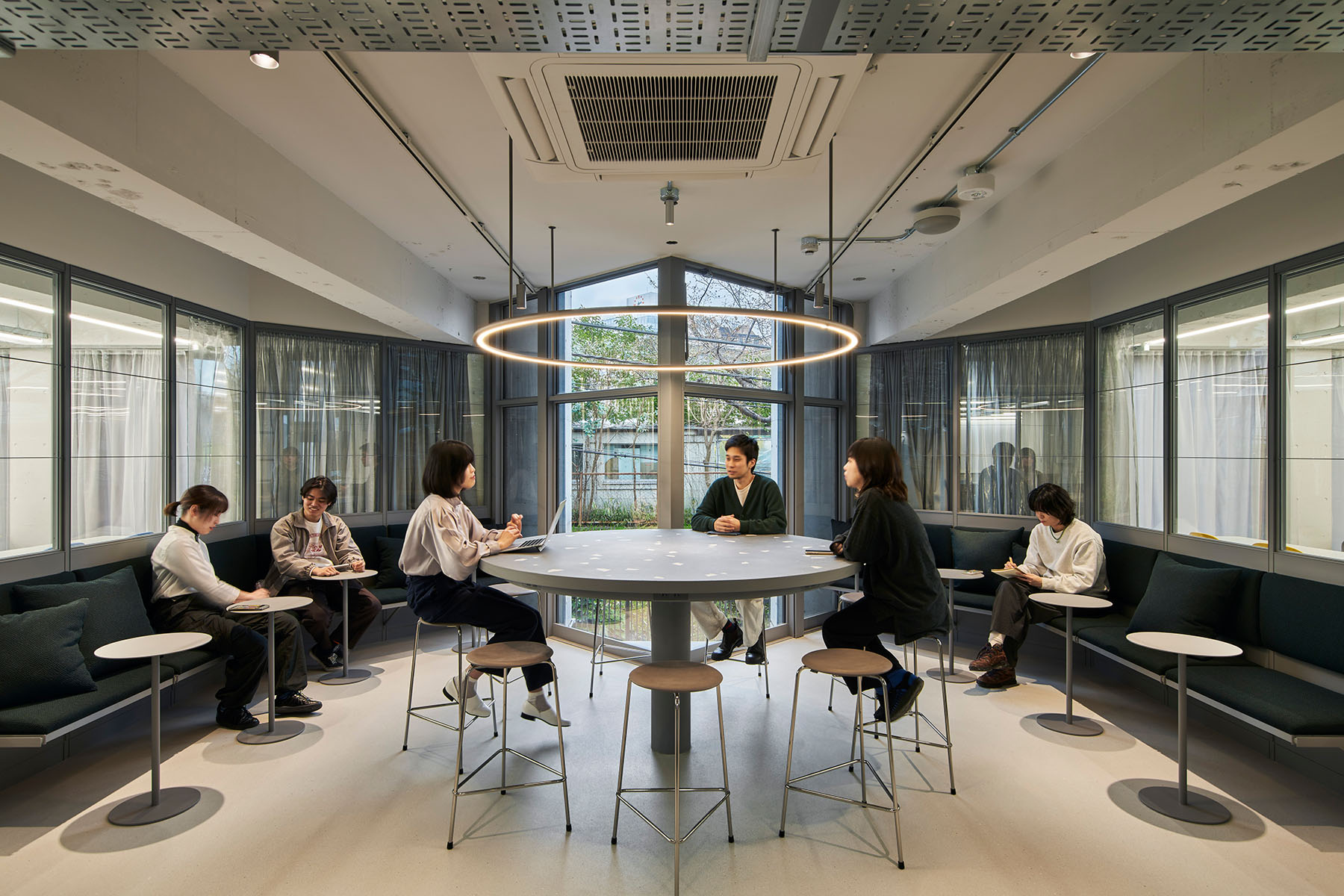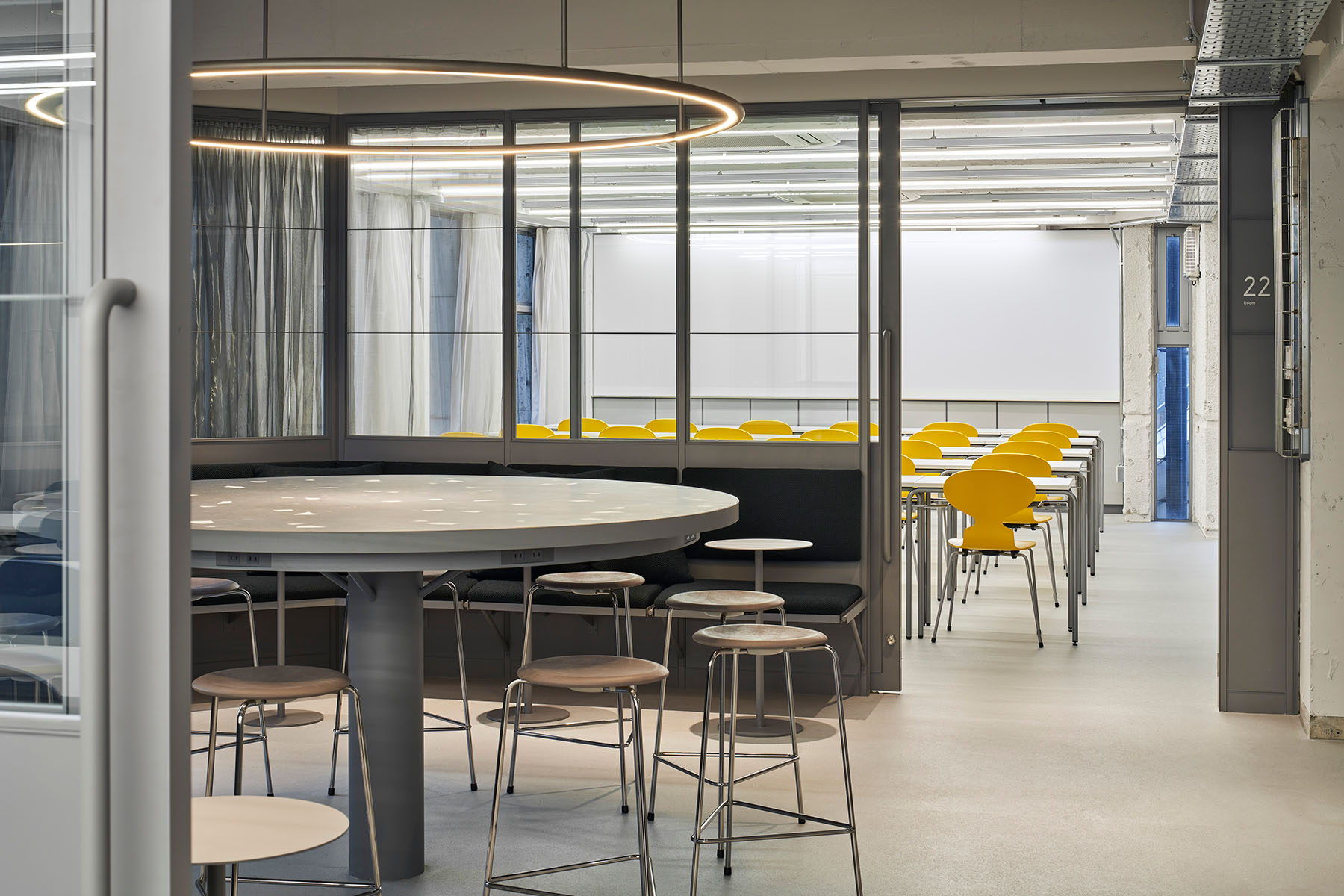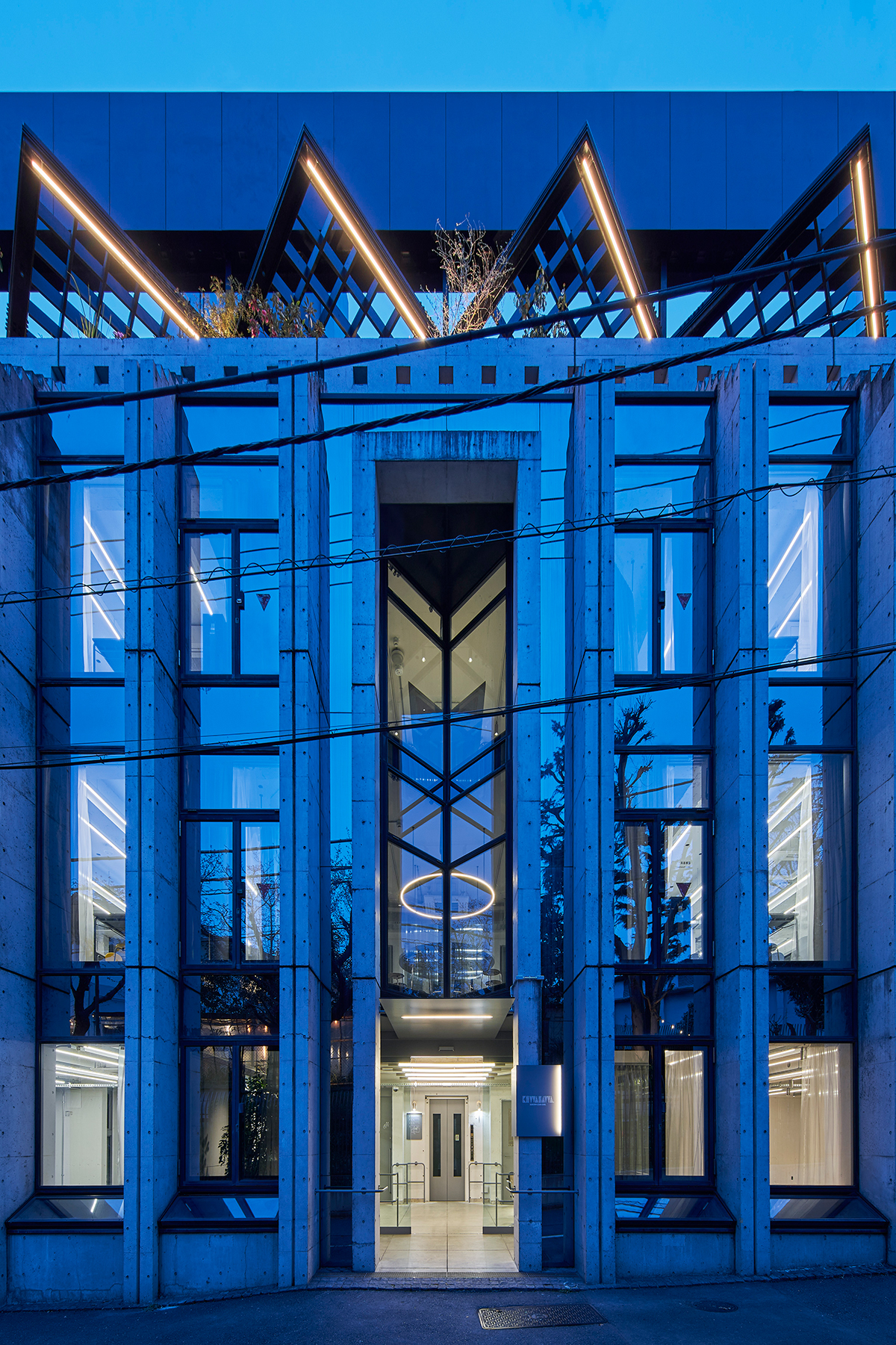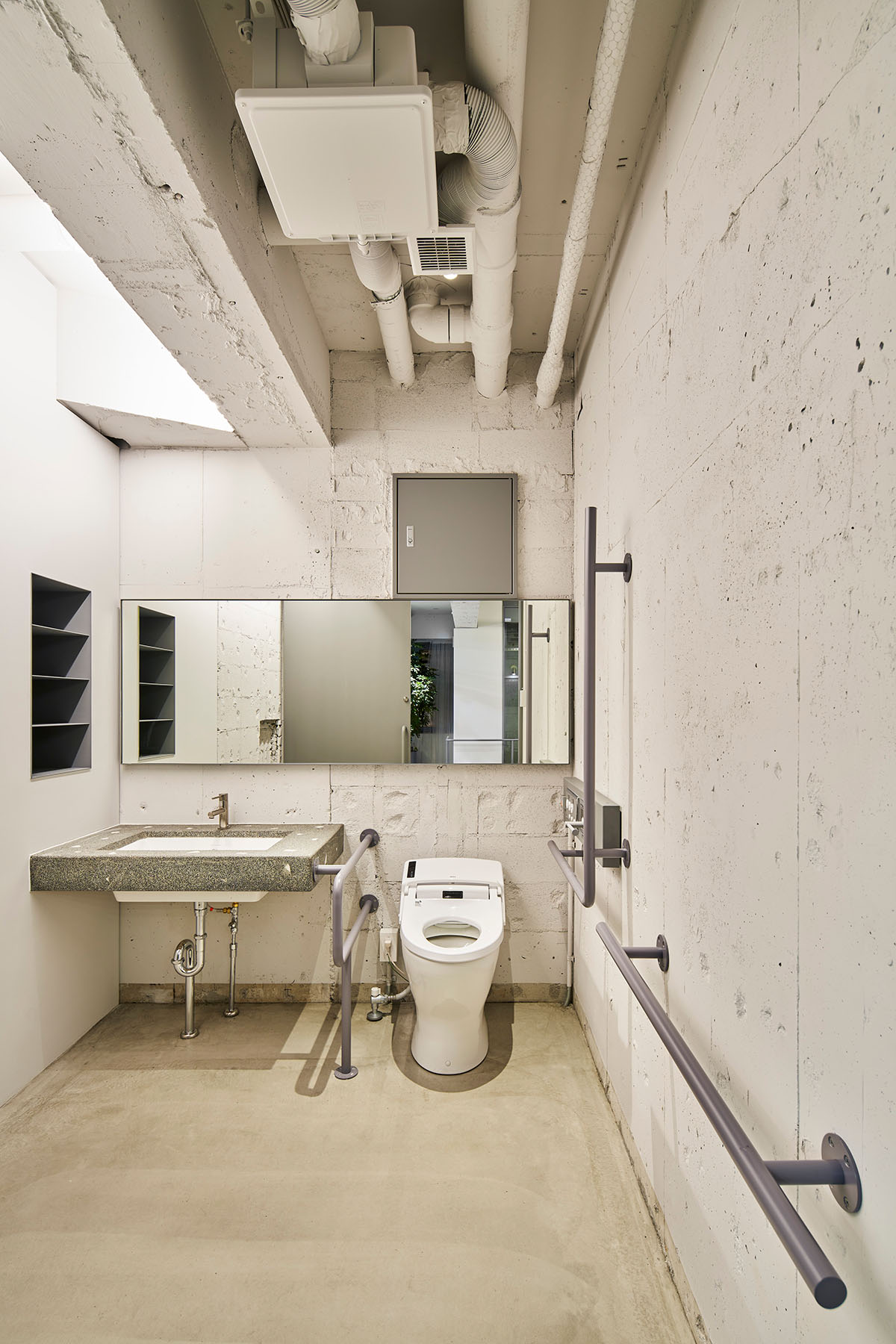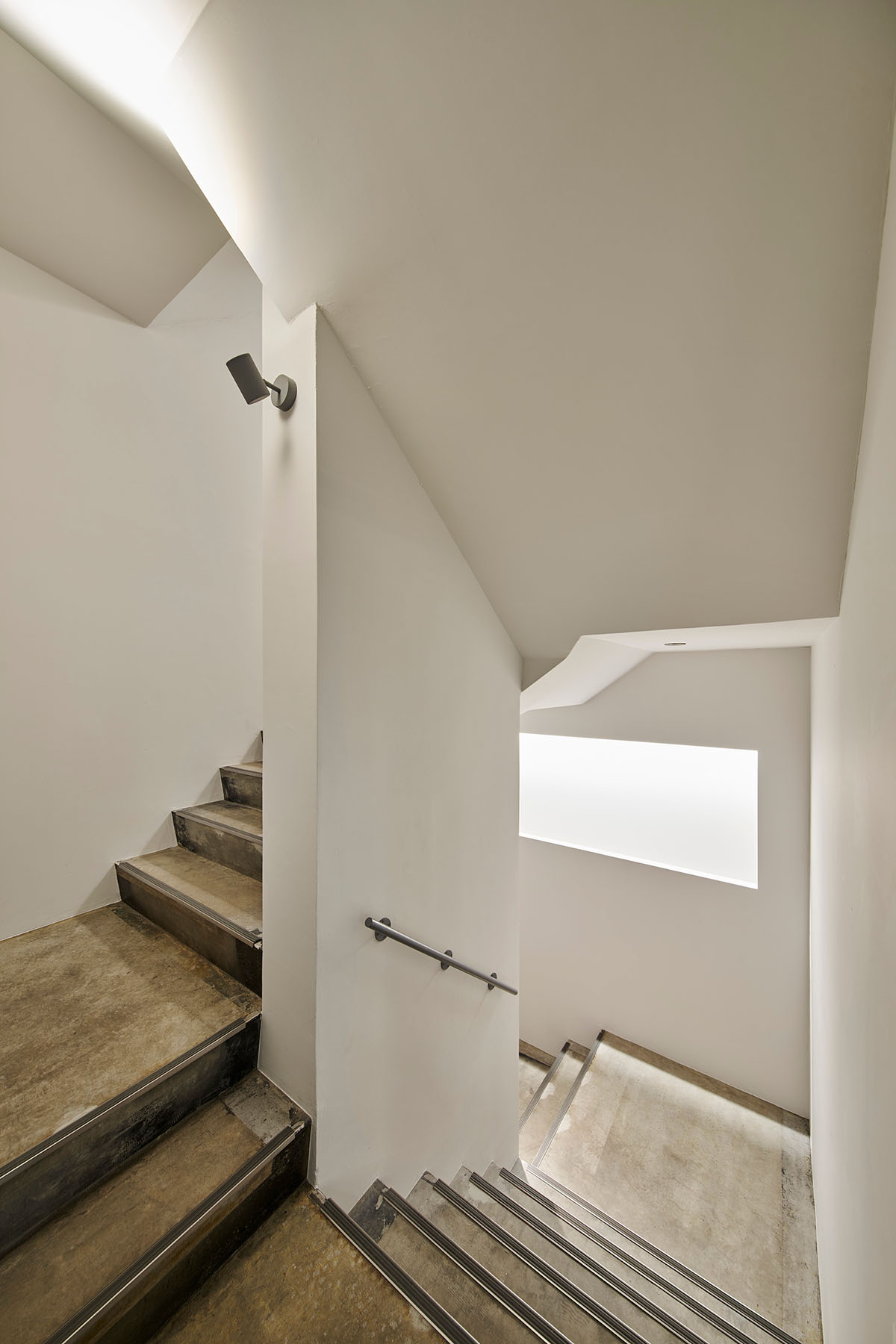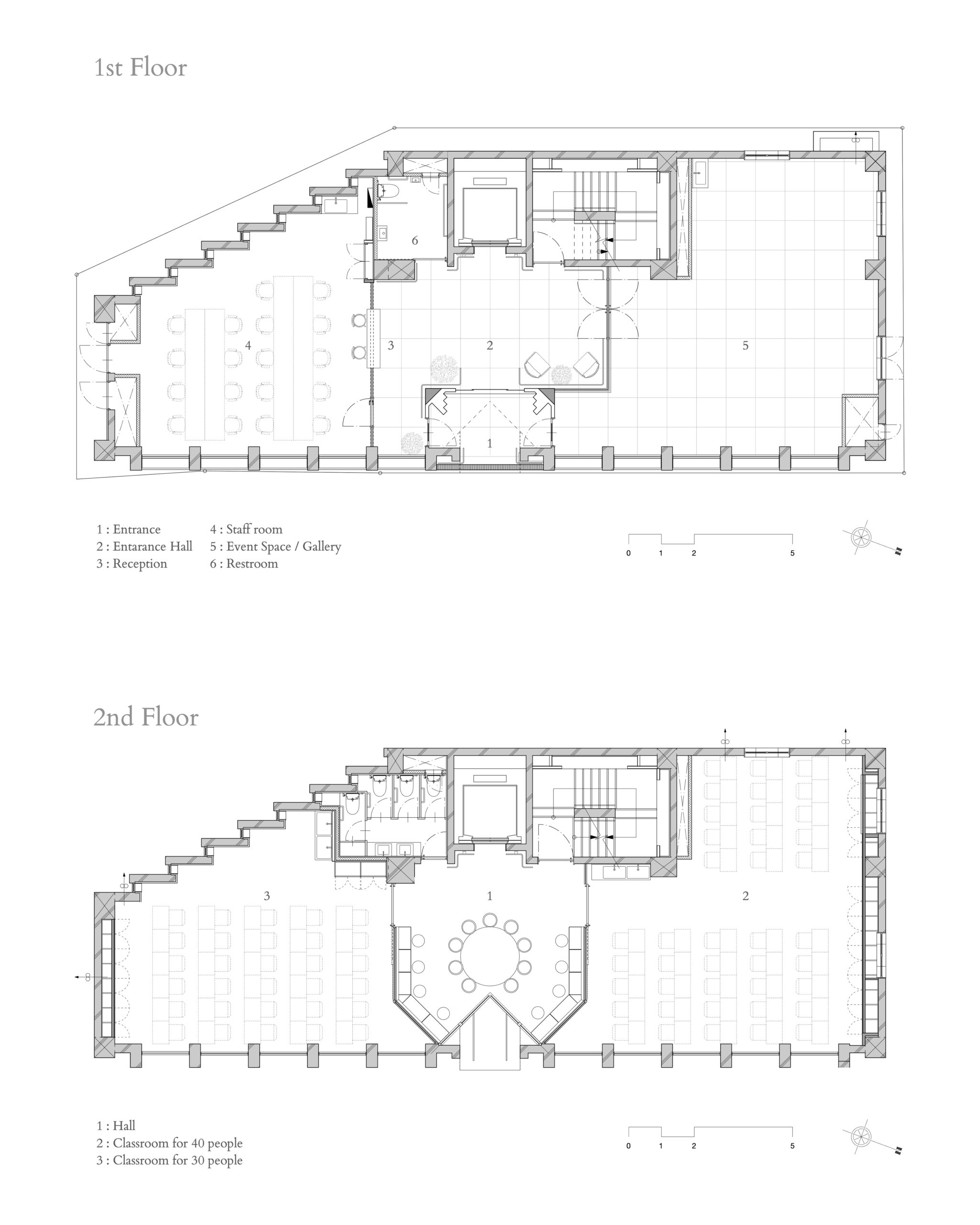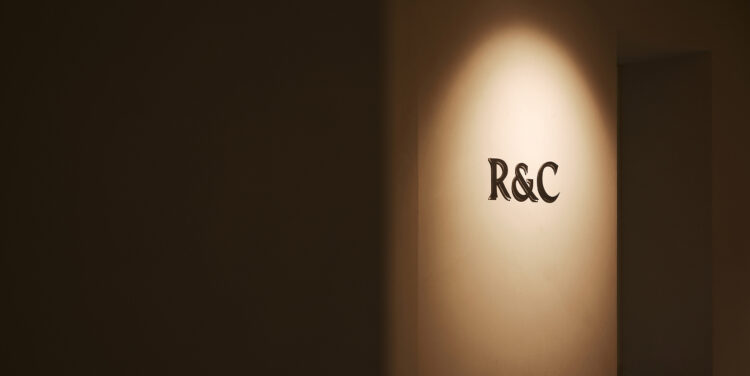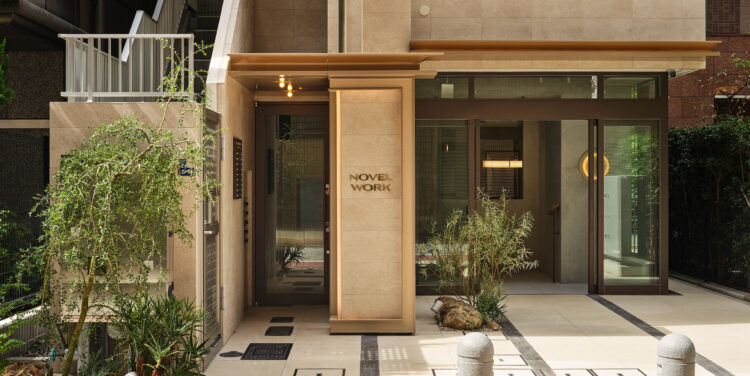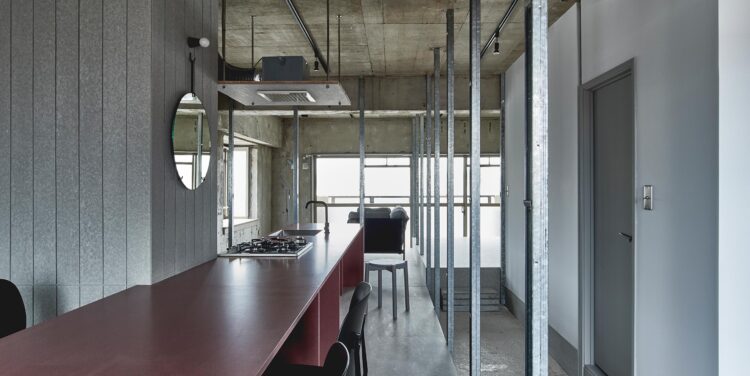Kuwasawa Design School #1 educational
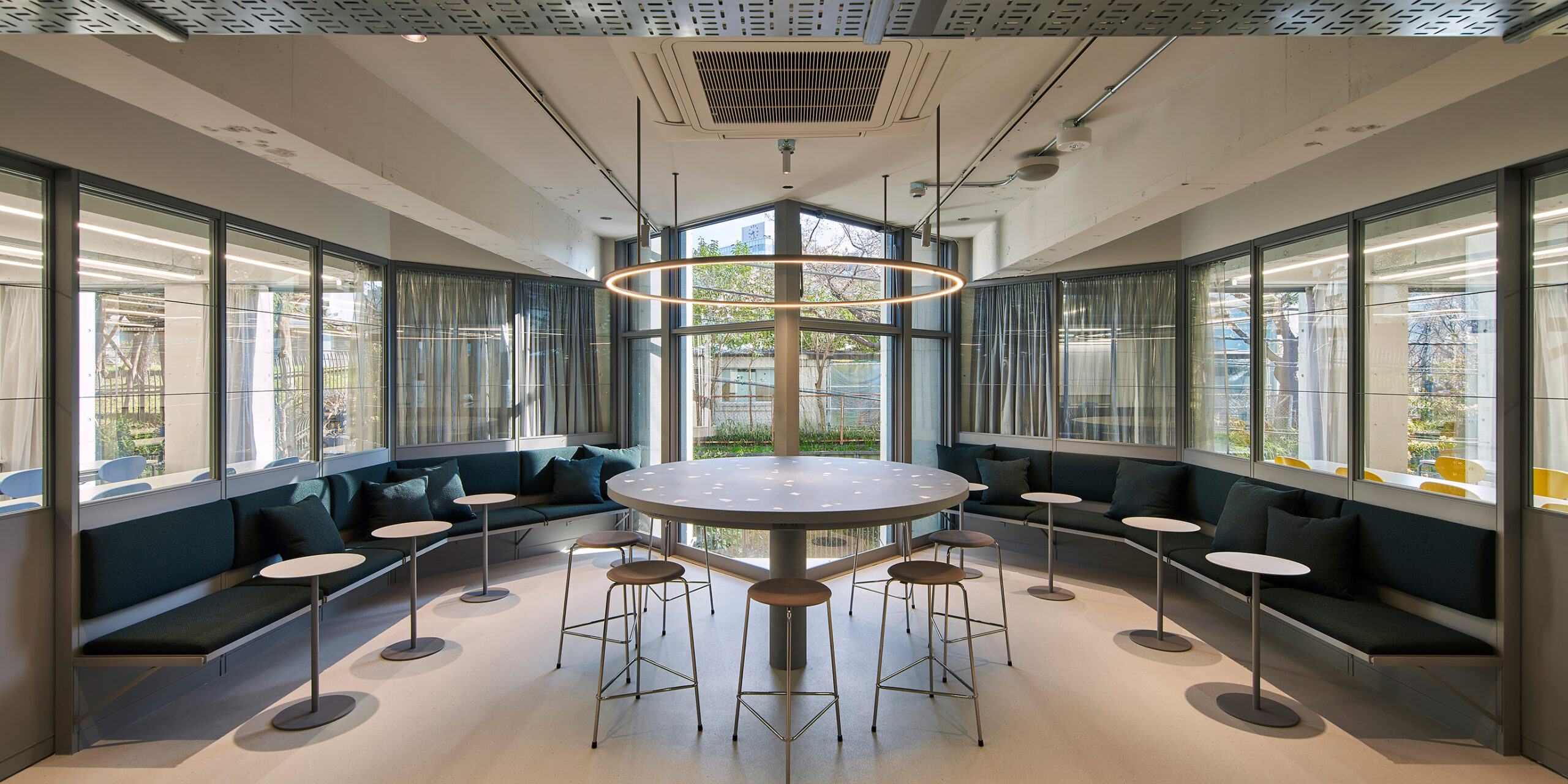
-デザインを探求しこの先のデザインを育む、未来の作り手たちのための場所。
日本で最初のデザイン学校である専門学校桑沢デザイン研究所新教育施設の1期工事。
現校舎からほど近い場所にある建物を全面的にリノベーションし、現校舎と併用して運用することで機能の充足を図ることから計画は始まった。
1期工事では地上1階から4階までを改修範囲とし、
建物の横に長くシンメトリーな形状を生かしたレイアウト計画とし、ユニバーサル化に伴う設備の一新や、効率的な動線計画による開放的な施設を目指した。
1階から3階は、中央にコモンスペースを設け、その両側にイベントスペースや教室など機能を持ったスペースを配置するように計画している。
イベントスペースは学校と外とを繋げるパブリックでフレキシブルなスペースにしたいという要望からファサードからの視認性を考慮し明るく開放的な空間としエントランス横から直接アプローチできるようになっている。
2、3階の教室間の中央に配したコモンスペースをにはベンチとハイテーブルを設け、用途によって使い分けができ生徒同士の繋がりを生むスペースとしても機能し授業間の隙間時間をより有意義なものにする。
4階は面積の半分以上が屋外となっており、代々木競技場と緑豊かな代々木公園を借景として望みながらそこをデッキ貼りのテラスとし造作のベンチや大きなテーブルやカウンターを設け、豊かな植栽を植えることで外との繋がりを意識した気持ちのいい場所として都会にいながらも自然を享受できる場所になればと考えた。
90年代に建てられたこの建物はポストモダンの空気を感じさせる特徴的なコンクリートの外観となっており内部は大理石が貼られた壁や板張りの床など古めかしい当時の内装が残っていた。
外観との対比を図るため、内装はあくまで数十年先を見据え恒久的なニュートラルさを意識し極力装飾は抑え、渋谷と原宿の中間地点ということもありどこか都会的なエッジを付加するようにデザインをしていった。
予算の分配も意識し、空間全体としては元々の躯体を顕にした部分を多くしこれから利用していく過程の中でアップデートできるようにして、ミニマムな仕上げや工夫によって各機能を持つ部屋を最大限に引き正すことを意識した。
本校がドイツの*バウハウスのデザイン理念を元に創設されたという経緯から、内装のマテリアルも、モダニズムの進歩を押し進めたスチール、ガラス、コンクリートをメインに使用し、手すりやサッシはデッサウで用いられたディティールを現代的にアップデートすることでリノベーションによる新旧と当時のバウハウスと現代のデザイン学校としての桑沢との新旧の対比を図っている。
要所に配したシンプルなアールの手すりや特注のカーテン、ファブリック、既存の大理石をアップサイクルした研ぎ出しの天板などによって、機構や機能が素の姿として空間を形成していく中で出てくる直線による強さを柔和し、人間的な暖かみを空間に持たせ、生徒たちが日々使う中で直接手や目に触れインスピレーションを喚起することも想定した。
スケルトンに塗装をした白い箱の中に多用したニュートラルなグレー(主張のない工業製品的なグレー)は、どこか都会的でありながらも中庸であり、デザインを探求する生徒たちが持つそれぞれの’色’を引き立たせる意味も持っている。
上記の要素により、この先もその普遍的な印象は都会の中で学ぶ学生にとってあくまでも自身の学びにフォーカスできるバランスを担う役割を持ち、
日本で最初のデザイン学校としての歴史を継承するおおらかな受け皿としてこの先も機能していくことを期待する。
*バウハウス
1919年に建築家グロピウスによってワイマールに建設された造形芸術の総合的な学校。 芸術と工業を統一する理念をたて、活発な造形教育を行い、その後の欧米の芸術、文化状況にも広く深い影響を残した。
-A place to pursue the future of design and nurture those who will design the future.
The first school of design in Japan, Kuwasawa Design School, expanded their facilities with a new building nearby their existing campus. The plan for the first phase of construction aimed to improve the functionality of the school’s facilities by fully renovating the new building to be operated in conjunction with the older school building.
In the initial construction phase, the project involved a comprehensive renovation, spanning from the ground floor to the fourth floor. The design approach harnessed the building’s distinctive long and symmetrical structure, and focused on enhancing functionality through universal design principles and an optimized circulation plan.
Across the first three floors, a central common space takes center stage, flanked by function-specific areas such as event spaces and classrooms. The event space, designed for flexibility and to foster public engagement, is visible from the façade and accessible directly from the entrance, creating a visual and spatial bridge between the school and the exterior. Meanwhile, the common space strategically positioned between classrooms on the second and third floors integrates benches and high tables, creating a seamless space for student interaction and enriching the gap time between classes.
On the fourth floor, over half of the area is used as an outdoor oasis, building harmony between the urban and natural environments. Decked terraces, complemented by custom benches, spacious tables, and approachable counters, all amidst a verdant landscape, offer an inviting haven where individuals can savor nature while remaining immersed in the urban milieu.
The building, constructed during the 1990s, boasts a distinctive concrete façade that reflects the influence of post-modernism. Its interior, on the other hand, retains vestiges of the era’s penchant for vintage charm, adorned with marble-clad walls and wooden floors. Adding to this contrast with the exterior, the interior design ethos leans towards timelessness and neutrality, and avoids excessive embellishments. Located between Shibuya and Harajuku, this approach introduces a touch of urban sophistication while remaining within the project’s allocated budget. The overall spatial strategy accentuates the existing structural framework, ensuring adaptability for future updates through minimalist finishes and thoughtfully curated details.
The institution’s foundation is rooted in the design principles of Germany’s Bauhaus.* Inside the renovated spaces, the predominant materials are steel, glass, and concrete – the very elements that drove the modernist movement.
This interior design pays homage to Bauhaus by reinterpreting its aesthetic, featuring clean, curved railings, custom curtains, textiles, and upcycled honed marble tabletops, all set against a backdrop of a white, skeletal structure painted in neutral grays, evoking an industrial yet unassuming ambiance. This design philosophy provides a neutral canvas for students of design to express their “color,” their unique design perspectives.
With these elements in mind, the space’s enduring impression will continue to offer balance, allowing students studying in the midst of Tokyo’s metropolis to focus on their own education. Inheriting its history as Japan’s first design school, the building is intended as a generous receptacle that nurtures the creative minds of the future.
*Bauhaus
Founded in 1919 by architect Walter Gropius in Weimar, Germany, the Bauhaus was a comprehensive school of visual arts that aimed to unify art and industry. It provided rigorous design education and left a profound influence on subsequent art and cultural movements in Europe and the United States.
—
Publicity/メディア掲載
—
Awards/受賞歴
ArchDaily Building of the Year Awards 2024 Nominee
IDPA Japan Design Award 2025 Gold
—
Movie : Shotaro Niikura (S Wood Works)
Movie : Kosuke Ino
DATA
- Type
- Design college
- Category
- Interior Design
- Date
- 2023.03
- Location
- Jinnan, Shibuya-Ku, Tokyo
- Size
- 881.6㎡
CREDIT
- Client
- 学校法人桑沢学園
- Interior design
- moss.
- Project management
- moss. | Studio inc.
- Construction
- Studio inc.
- Partners
- KENT | GM co.ltd | Filaments inc. | ADDICT | Tan | MARVELOUS | CUSTOM | BP. | L&L | fabricscape | KVADRAT | BOOTLEG | Yumi Matsushita | 美光 | クオン | 木戸浦工業
- Photo
- Koji Fujii (TOREAL)


